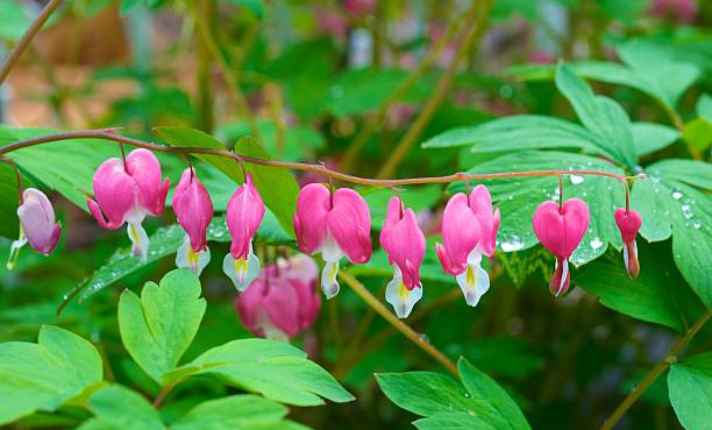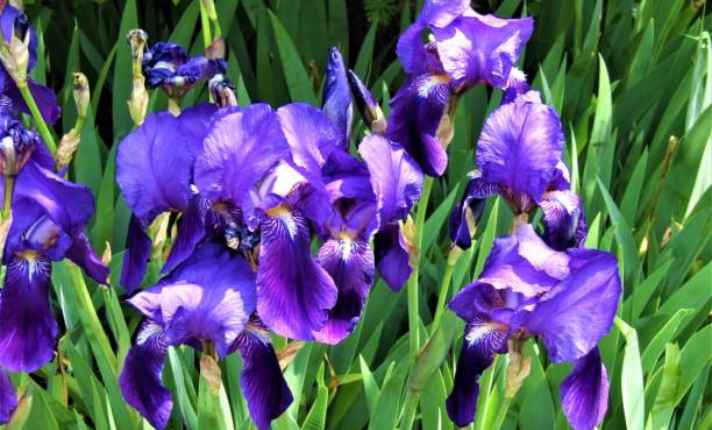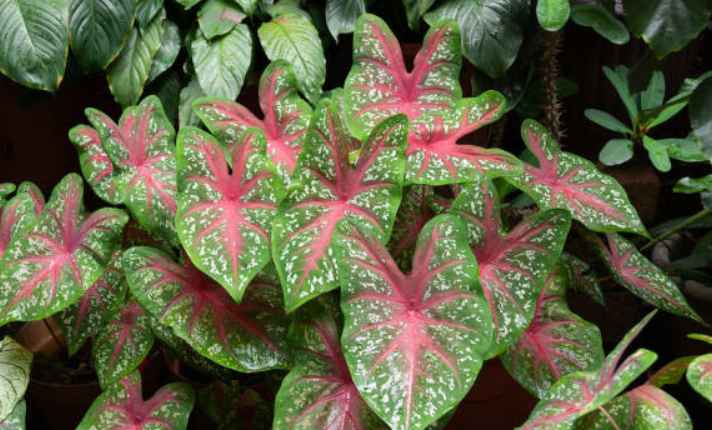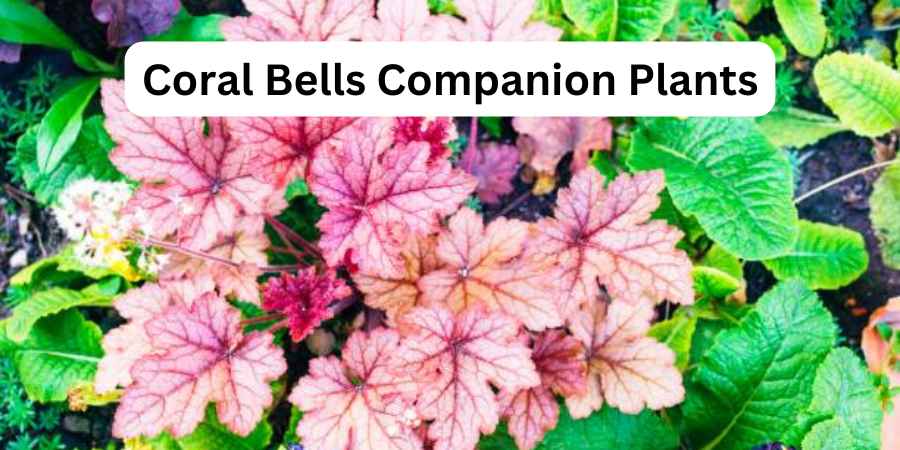Last Updated on June 1, 2025 by Jocelyn
Heuchera, commonly called coral bells, are shade-tolerant perennials known for their colorful foliage and delicate bell-shaped flowers.
They grow well in USDA zones 4 to 9 and prefer partial sun (4–6 hours daily) with neutral to slightly acidic, well-drained soil.
These low-maintenance plants are ideal for garden borders, containers, or woodland gardens and provide multi-season interest.
Good companion plants for coral bells include bleeding heart, iris, astilbe, begonia, caladium, ferns, hostas, and ornamental grasses.
These plants share similar light and soil needs, helping to fill space while adding texture, color, and height variation.
Placing coral bells alongside these companions creates a balanced, layered look and encourages healthy growth throughout the season.
Table of Contents
ToggleBenefits of Companion Planting With Coral Bells
Coral bells are beautiful plants that are great for gardens. They have colorful leaves and tiny flowers. When you plant them with other plants, they help each other grow better.
Here are some benefits of planting companion plants with coral bells:
| Benefit | Description |
| Shade | Coral bells provide shade for smaller, shade-loving plants, protecting them from harsh sunlight. |
| Pest Control | The scent of coral bells can deter pests, reducing the need for chemical pesticides. |
| Soil Health | Coral bells improve soil quality by adding organic matter as they grow and decompose. |
| Attracting Pollinators | The flowers of coral bells attract bees and butterflies, helping with pollination in the garden. |
Best Companion Plants for Coral Bells
Choosing the best companion plants for Coral Bells can enhance their growth and add beauty to your garden.
Look for plants that thrive in shade, have varied textures and foliage, and are low-maintenance. These companions will create a visually appealing and healthy garden space.
Shrubs to Plant With Coral Bells
If you’re looking for beautiful shrubs to plant with coral bells, consider hydrangeas and mountain laurel.
Hydrangeas are flowering shrubs with big clusters of flowers that bloom in the summer. Their greenery makes a nice backdrop for the brightly colored foliage of coral bells.

Another great choice is the spring-blooming mountain laurel, which has flowers in red or pink hues that complement the bright leaves of coral bells.
While the flowers of mountain laurel may fade by summer, its glossy green foliage stays beautiful, giving a neutral backdrop for the coral bells. Mountain laurel can be grown in full sun to partial shade.

Planting coral bells around the base of these shrubs helps protect this perennial from too much sunlight.
Perennials to Plant With Coral Bells
When planting coral bells in your garden, consider adding a bleeding heart with its showy flowers and dramatic foliage.
Both plants share similar sunlight requirements and soil requirements, preferring morning sun and afternoon shade, as well as rich soil, well-drained soil, and slightly acidic soil.

The bleeding heart can grow 1 to 3 feet tall, so you can plant the tall varieties behind the coral bells and the smaller varieties alongside them.
Another great companion is the iris, with its purple flowers, blue flowers, white flowers, and yellow flowers. The iris offers a range of colors that contrast beautifully with the intense hues of the coral bells’ foliage.
Iris plants have narrow flower stems and upright, sword-like greenery. Place them in a mixed bed or border for a striking look.

Sun Perennials
Sun perennials are wonderful plants that thrive in sunny gardens. They bring vibrant colors and are easy to care for, making any garden look lively and beautiful.
Here are some great sun-loving plants that pair well with coral bells:
| Plant Type | Description |
|---|---|
| Daylilies | Sun-loving plants with many blooms. They grow in clumps and pair well with coral bells. Their vibrant flowers add a lively touch. |
| Lupine | Tall, rainbow-hued flower spikes. These plants bring a cozy, cottage-like feel and add height while coral bells cover the ground level. |
| Pansies | Small plants that bring joy in cool seasons. They add color to the garden early in spring before coral bells show their vivid leaves. |
| Other Companions | Artemisia, bugleweed, geranium, iris, lady’s mantle, Lysimachia, and ornamental grasses also make great companions for coral bells. |
Shade Perennials
Coral bells are beautiful plants that can be paired with many others to make your garden look stunning. They thrive in different conditions, including shady areas.
Here are some great shade perennials to plant with coral bells:
| Plant Type | Description |
| Hosta | Hostas love shade and their leafy look contrasts nicely with coral bells. The bold leaves of hostas and the fine leaves of coral bells create a nice contrast. |
| Astilbe | Astilbes are perennials with feather-like blooms and ferny leaves. Their fluffy look adds dimension to garden beds. Their flowers last a long time, making them perfect with coral bells. |
| Trillium | Trillium is a plant native to North America with three-petaled flowers and wide leaves. Planting them with coral bells creates a woodland garden look. They bloom at the same time, giving a pleasing display of fresh, spring plants. |
| Other Companions | Combine woodland plants like astilbe, bleeding heart, ferns, hellebores, hosta, Japanese forest grass, and Lamium with coral bells. |
Annuals to Plant With Coral Bells
If you want to make your garden colorful, you can plant caladium with coral bells. Caladium has big, heart-shaped leaves that come in many colors like white, green, red, and pink.
Some leaves are even mottled, veined, or striped. Both plants love a shady spot and need slightly acidic soil to grow well.

Caladium and coral bells together create a mix of formal appearance and abstract look. While coral bells bloom with small flowers in pale colors, the foliage of caladium stands out.
Many gardeners like to prune the flower buds of caladium to focus on its leaves.
Flowering Annuals
Flowering annuals are a wonderful addition to any garden. They bring vibrant colors and interesting shapes that brighten up the space throughout different seasons.
| Plant Type | Description |
|---|---|
| Impatiens | Adaptable annuals thrive in the shade, making great companions for coral bells. Their bright flowers add color and interest among green leaves. |
| Petunias | Flowering annuals with lush blooms and vine-like growth. Used as a border for coral bells, they enhance the color and texture of the garden bed. |
| Begonias | Shade-loving annuals with eye-catching flowers in various colors and shapes. They grow close together, adding bright, charming blooms to shade-filled spots with coral bells. |
Plants Not to Grow With Coral Bells
Coral bells, or Heuchera, are beautiful plants that love slightly acidic soil and need weekly watering. They grow best in full sun but can also tolerate deep shade.
However, some plants are a poor match for coral bells because they have different care needs and environmental necessities.
| Plant | Reason for Poor Match |
| Lavender, Yucca | Prefer sandy, dry soil and lots of sun |
| Lilacs, Hydrangeas | Create a close canopy, blocking sun |
| Coneflowers | Aggressive growers that steal water and nutrients |
| Salvia | Aggressive growers that take over space |
| Lemon balm | Spreads quickly, competing for resources |
For more about companion planting, check out my guides:
- Lemon verbena companion plants
- Companion planting chives
- Bok choy companion plants
- Oregano companion plants
Planting & Caring Tips for Coral Bells
Coral bells are wonderful perennials that add beauty to any garden. They are very easy to grow and can adapt to many different conditions. Here are some tips to help you plant and care for your coral bells:
- Coral bells thrive in USDA zones 4-9 and can tolerate various light conditions, poor soil, heat, cold, humidity, and drought.
- Their foliage comes in many colors, including silver and almost black, with leaves that can be patterned, ruffled, wavy, or smooth.
- The flowers come in shades of coral, red, white, or pink and attract butterflies and hummingbirds.
- Plant them in spring or fall and space them 1-2 feet apart for the best growth.
- They grow best with 4-6 hours of direct sunlight, though they can also thrive in shade.
- Heuchera prefers rich, well-draining soil but can also grow in clay, rocky soils, and with some salt.
- If you have heavy clay garden soil, amend it to improve drainage or use a raised bed.
- Keep the soil moist but not soggy; they are drought-tolerant once established but need extra water during hot spells.
- Use compost or a balanced, slow-release granular fertilizer in the spring for fertilizing.
- For container-grown plants, follow the instructions for a water-soluble fertilizer.
- Pruning involves trimming the tattered foliage in early spring.
- They grow well in pots with a hole at the bottom to let excess water drain.
- If you want them to return next year, transplant them to the landscape in early fall.
FAQ’s
Q: Where Is the Best Place to Plant Coral Bells?
A: Coral bells are great plants to grow in prairies, mountains, and woods. They can also thrive in more arid climates. When picking the best location, make sure they get partial shade.
They do well with a bit more sun in colder climates. Plant them in well-draining, humus-rich soil. It’s best to grow them near trees and taller-growing plants since they can handle less sun there.
Q: Do Coral Bells Prefer Sun or Shade?
A: Coral bell plants like partial shade but can grow in more sun if the climate is cold. They need well-drained, moist, rich soil that is neutral to slightly acidic, with a pH of 6.0 to 7.0. Some species, like H. sanguinea, don’t do well in clayey or highly acidic soils.
Q: Do Coral Bell Plants Spread?
A: I love using Coral Bells in my garden because they are perfect for ground cover. In just a few years, they can spread and fill a garden bed nicely.
When you plant them, make sure to place them 18 to 24 inches apart from other plants like hostas, and away from buildings. This gives them enough room to grow.
Q: How Long Do Coral Bells Last?
A: Coral Bells are perennial plants that can be grown in pots, containers, or along the edges of lawns, driveways, fences, or pathways.
They typically live for about three to four years. As they age, they become stronger and more vibrant instead of weaker and smaller like some other plants.
Q: Do Coral Bells Need a Lot of Water?
A: When Coral Bells are first planted, they need daily watering for the first week. After that, during the remainder of the first growing season, they require consistent water.
This means every few days is typically enough. Once the plants are established, they become somewhat drought tolerant, so weekly watering is enough.
Conclusion
When you plant coral bells in your garden, you can make them look even better by adding the right companion plants. These are plants that grow well together and help each other look their best.
For example, hostas are a great choice because they have large leaves that look good next to the coral bells’ colorful foliage.
Ferns are also nice companions because their delicate leaves create a pretty contrast. Another good option is astilbe, which has feathery flowers that complement the coral bells’ blooms.
By choosing the right companion plants, you can create a beautiful garden that is full of color and texture.

